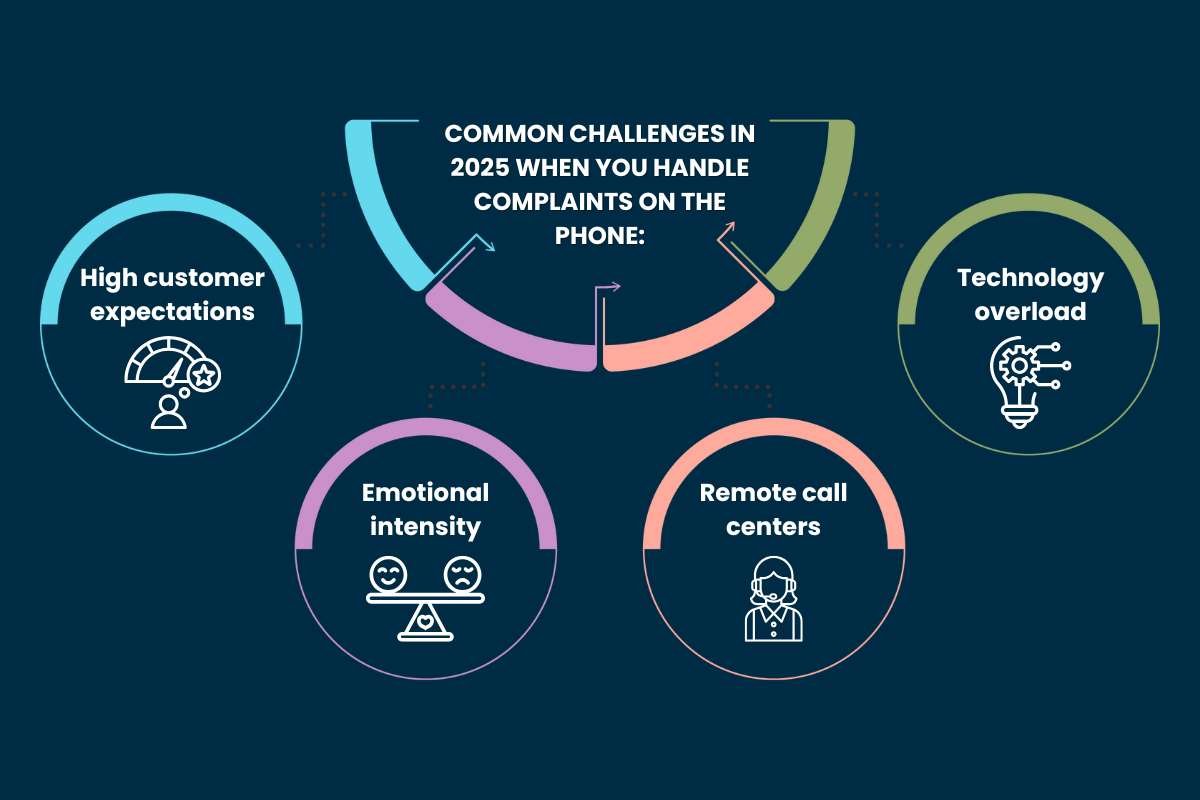Some days, the phone rings, and on the other end is a customer who seems determined to turn a frustrating situation into a truly bad day. Their words are sharp, their tone is angry, and it feels like everything you say only makes things worse. You know that getting a satisfying resolution is vital for the customer and for your company. But in that moment, it’s hard to see a way out. It’s a common challenge for customer service professionals to know how to handle complaints on the phone when the person on the other end is at their breaking point.
Can you turn a fiery, frustrating phone call into a calm, positive outcome? The answer is yes. There are powerful techniques that can defuse anger and guide even the most upset customer toward a resolution where they feel heard and respected.
If you’ve ever felt lost on one of these calls, you’re about to discover how to handle complaints on the phone. And how you can survive and transform them. Are you ready to find out how?
Why Process to Handle Complaints on the Phone Matters in 2025?
In a world dominated by AI chatbots, the human voice remains a powerful tool for building trust and accountability. When customers are upset and need to vent, a real voice offers the empathy and understanding they’re truly seeking. It is something a generic chat reply can’t provide. This personal connection isn’t just about good service. It is a critical retention opportunity. Studies show that effectively resolving complaints can increase customer loyalty by up to 30%, transforming a negative experience into a positive one and reinforcing the value of human interaction.
Common Challenges in 2025 When You Handle Complaints on the Phone:

- High customer expectations – Today’s customers demand immediate, effective solutions. They have little patience for long hold times, being transferred repeatedly, or generic responses, expecting a seamless experience that gets to the point quickly.
- Emotional intensity – Social media has given customers a public platform to vent their frustration, so by the time they call, their anger is often amplified. This increased emotional intensity makes it much harder to de-escalate the situation and find a calm resolution.
- Remote call centers – With many teams working remotely, it’s a challenge to maintain consistent training, coaching, and a unified tone of service across all agents. This can lead to variations in how complaints are handled, making the customer experience less predictable.
- Technology overload – Customer service representatives often have to juggle multiple tools at once, including CRM software, AI assistants, and call-logging systems. This technological burden can be overwhelming, distracting them from focusing on the customer and their specific needs.
Tools and Techniques That Make Handling Complaints Easier:
In 2025, businesses will have more tools than ever to support employees.
1. AI-Powered Call Assistants
These assistants are a game-changer for live calls. They use AI to analyze the customer’s tone and words in real time, giving agents suggestions for empathetic phrases to use. This helps agents stay a step ahead and respond to the customer’s emotions effectively.
2. CRM Integration
When a customer calls, CRM platforms like HubSpot and Salesforce immediately bring up their entire history. This gives the agent a complete picture of past issues, purchases, and interactions, so they don’t have to waste time asking the customer to repeat themselves.
3. Speech Analytics
This technology helps supervisors understand what happens on the calls. It analyses the conversations for things like the customer’s frustration level and key phrases, providing valuable data that managers can use to create better training programs for their team.
4. Soft-Skills Training Apps
These apps make training interactive and fun. They create realistic scenarios with angry customers, allowing employees to practice their responses in a safe environment and build the confidence needed to handle real-world situations with empathy and calm.
The 14 Best Tips to Handle Complaints on the Phone in 2025:
We have a curated list of things that you can practice while on a call with an angry customer. These Tips on how to handle complaints on the phone will improve your customers’ experience and increase loyalty.
1. Listen First, Solve Later
The most effective way to start any complaint call is by listening. Customers want to feel heard and understood before a solution is even offered. By letting them fully explain their issue without interruption, you show respect and gather crucial information, making it easier to find the right fix.
2. Acknowledge, Don’t Over-Apologize
A single, sincere apology is far more powerful than a dozen repetitive ones. A simple “I’m sorry this happened” acknowledges their frustration and shows you take their issue seriously, allowing you to quickly move on to action, which is what the customer really wants.
3. Show Genuine Empathy
Empathy phrases like “I understand how frustrating this must feel” validate the customer’s emotions and build a bridge of trust. This shows you’re on their side and invested in finding a solution, which can instantly de-escalate tension and turn a heated conversation into a collaborative effort.
4. Stay Calm and Collected

Your tone sets the tone for the entire conversation. By remaining calm, you create a sense of control and professionalism, which can soothe an angry caller and prevent the situation from escalating.
5. Keep a Friendly, Professional Tone
A warm, professional tone can make a significant difference. Using polite and positive language helps build rapport, making the customer feel more at ease and more likely to cooperate in finding a solution.
6. Identify the Root Cause Quickly
Focus on getting to the heart of the issue without getting sidetracked by vague statements. Asking specific questions like, “What exactly isn’t working for you?” helps you pinpoint the problem and find a faster, more accurate solution.
7. Ask What They’ve Already Tried
Before jumping in with a solution, find out what steps the customer has already taken. This prevents you from suggesting a fix they’ve already tried and failed with, saving time and avoiding further frustration.
8. Use Empowering Language

Swap passive phrases for proactive ones. Saying, “Let me find the right solution for you,” instead of “I don’t know,” reassures the customer that you are in control and are committed to resolving their problem.
9. Be Transparent About Solutions
Set clear and realistic expectations for what can be done and how long it will take. Honesty builds trust, while over-promising and under-delivering will only lead to more complaints.
10. Communicate Actions Clearly
Keep the customer informed about what you’re doing in real-time. By narrating your actions, you show them you are actively working on their issue, which reduces anxiety and makes the process feel more collaborative.
11. Avoid Long Holds or Explain Them
Placing a customer on hold for a long time can add to their frustration. If a hold is necessary, always ask for permission first and provide a quick update if it takes longer than you expected.
12. Resolve Issues Swiftly

Quick resolution is key to customer satisfaction and loyalty. The faster you can solve a problem, the less likely it is to escalate, leaving the customer feeling relieved and well-cared for.
13. Follow Up After the Call
A follow-up email or quick phone call demonstrates that you care about their experience even after the initial issue is resolved. This extra step can turn a satisfied customer into a loyal advocate for your brand.
14. View Complaints as Opportunities
Each complaint is a chance to not only fix a problem but to show the customer how much you value their business. A well-handled complaint can strengthen customer loyalty and provide valuable feedback for improving your service.
Pro Tips for Managers:
These pro tips for managers for training agents on how to handle complaints on the phone are solid strategies for building a strong, customer-focused team.
1. Continuous Training
Investing in continuous training is like giving your team a fitness regimen for their skills. A one-time training session is a great start, but customer interactions and company policies evolve. Regular, quarterly refreshers ensure that your staff stays sharp, confident, and up-to-date, preventing them from falling into outdated habits.
2. Call Monitoring
The key to using call monitoring effectively is to reframe it. Instead of a tool for catching mistakes, present it as a valuable coaching opportunity. When you listen to calls together, you can provide constructive feedback, celebrate successes, and help your employees grow their skills in a supportive environment rather than a punitive one.
3. Rewarding Excellence
Rewarding excellence in handling complaints shows your team that you value their hard work and emotional labor. By celebrating employees who successfully turn a customer’s frustration into a win, you create a positive feedback loop. This recognition motivates them and reinforces the idea that handling difficult situations well is a valuable and celebrated skill.
Conclusion
The process of how to handle complaints on the phone involves more than just solving the customer’s problems; it is a way to create enduring loyalty. By utilizing empathy, using smart technology, and applying these practical strategies, we can re-frame challenging conversations into golden opportunities for connection and trust. A complaint is never a dead end; it is an opportunity to demonstrate that you care, you care, and want to do what is right by the customer. The most successful teams know every difficult call is a victory waiting to be found.
FAQ:
1. Why is handling complaints on the phone important for businesses in 2025?
Handling complaints on the phone allows businesses to resolve issues in real-time, build trust, and retain customers. Even with digital channels available, customers often prefer voice calls for urgent or sensitive issues, as they create a personal connection that text or email cannot replicate.
2. How can employees stay calm during difficult complaint calls?
Staying calm when you handle complaints on the phone requires active listening, controlled breathing, and focusing on the solution rather than the customer’s anger. Using empathetic language and maintaining a friendly, professional tone can prevent escalation and make the conversation productive.
3. How can handling complaints on the phone improve customer loyalty?
A well-handled complaint demonstrates that the business cares about its customers. Quick resolutions, empathetic communication, and follow-ups leave customers feeling valued, increasing the likelihood of repeat business and positive word-of-mouth.


















